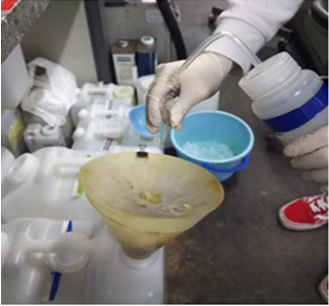Introduction
Chemistry
students can handle substances safely by knowing what is dangerous and what
is not dangerous. There was education rather than reprimand, and students were
imbued with the lessons of failure [1]. In my laboratory, when dealing with a
new substance for myself, when ordering reagents other than replenishment, I am
supposed to grasp the properties of the substance with the Safety
Data Sheet (SDS) as well as the usage method (reaction scheme etc.). Other
than that, when reconfirming how to handle particularly dangerous reagents
(Note: there is no safe reagent in a laboratory!), refer to manual books such
as "To conduct experiments safely" series and SDS to handle them
properly [2-4].
Case
1: Easy to overlook (metal powder).
When a solid metal that does not react with a solid
metal becomes a powder, a catalyst having a low ionization tendency can be a
strong catalyst. The finer the powder, the higher the reactivity and it is
necessary to pay attention to the dust explosion. For example, in platinum, the
bullion is a nonflammable type, and the fine powder is a catalyst, and there is
a risk of fire or explosion due to many reactions. That is, the shape of the
metal, its surface condition, and the particle size. Attention should be paid
to the reaction scale, impurities and reagent purity. There are many accidents
of dust explosion caused by metal powder. Indeed, conditions of powder samples
cannot be constant (Figure 1).
Moreover, in the cases of accidents that could not
be predicted from the Japanese
Fire Service Act or SDS (namely, properties of chemicals), two cases in the
lecture were due to static electricity in different situations. One of them was
caused by poor maintenance of apparatus, so it could be prevented with good
care. However, in the other case, the static electricity of the spatula and the
container caused the organic solvent to explode, and it would be impossible to
prevent this (without conditions or details of handling in which it was used).
[Question]
It was stated that the properties of substances are often related to metal
lumps, but SDS, which provides information
on toxic substances, is in a different state, such as the danger of not
only the state of metal lumps but also the state of powder. Is it possible to
confirm the danger in? I think it would be ideal to be aware of it with
knowledge, but I would be alert to the dangers not mentioned in the SDS.

Figure 1: Some examples of powder XRD patterns of metal complexes.
Case
2: Opinions are divided (cyanide).
Accidents of accidental ingestion of chemicals are
quite rare, but they are still not completely preventable, and as described in
the "To conduct experiments safely" series, mistakes in potassium
cyanide there is also a fatal thing called drinking. When a man drank tea with
only hot water during a break between experiments using Potassium
Cyanide (KCN), my vision became dark and I fainted. He was taken to the
emergency room because he shouted "Potassium cyanide!" [2]. On the
verge of fainting, and he survived. The accident was caused by not washing
hands after the experiment.
[Question] I
received some advice from an assistant professor to teach undergraduate student
experiments, but potassium cyanide becomes highly toxic hydrogen cyanide when
deliquescent, and it is very dangerous and difficult to handle, so it is better
not to use it in undergraduate student experiments as much as possible. It
seems that some graduate students are reluctant to use it, so it would be
better to change the reagent.
Case
3: About fire extinguisher in chemical laboratory
In the material of the lecture, there were various
fire extinguishers for the chemistry laboratory. In the example of a French
university, there were as many as three types of fire extinguishers (Figure 2). However, in our university,
we only have common powder (ABC) fire extinguishers. Certainly, it seems to be
able to handle all three types of fires A, B, and C. [Type A fire (ordinary fire): Fire burning wood, paper, clothing,
etc. Type B fire (oil fire): A fire
that burns petroleum, gasoline
(flammable liquid), oils and fats, etc. Type
C fire (electric fire): Fires involving electrical facilities such as
electrical equipment and appliances that may cause electric shock].
[Question] But
is it okay if there is no fire extinguisher with other characteristics? Also,
are there not only fire extinguishers but also sand buckets? In the first
place, which fire is classified as a fire caused by a chemical substance
(reagent)?

Figure2:Fire extinguishers of a French university.
Conclusion
Since it is a chemistry laboratory, please be able
to handle such substances safely, which is another opinion for the Question of
Case 2. First, check the SDS for general properties and figure out what you
shouldn't do in the experiments. Gloves are a must, of course (Figure 3). Solids should be weighed
quickly and treated as a basic solution. I think the four-sided transparent
cell that measures fluorescence had a lid. There is also a draft in the room.
Check with a universal test strip and be careful so that the waste liquid tank
becomes basic Hydrogen
Cyanide (HCN) gas can be generated if it is acidic.

Acknowledgement
The
author thanks Dr. Dohyun Moon (Pohang Accelerator Laboratory, Pohang, Korea)
for powder XRD measurements.
References
- https://www.msn.com/ja-jp/news/opinion/
- Editorial
Office of Kagaku-Dojin. To carry out the experiment safely 8th Ed (2017)
Kagaku-Dojin, Kyoto, Japan.
- Editorial
Office of Kagaku-Dojin. To carry out the experiment safely 24th Ed
(2017) Kagaku-Dojin, Kyoto, Japan
- https://www.sigmaaldrich.com/life-science.html
Corresponding author
Takashiro Akitsu, Department of
Chemistry, Faculty of Science, Tokyo University of Science, 1-3 Kagurazaka,
Shinjuku-ku, Tokyo 162-8601, Japan, E-mail: akitsu2@rs.tus.ac.jp
Citation
Akitsu T. From students questions of
safety education in a chemistry laboratory (2021) Edelweiss Chem Sci J 4: 14-15.
Keywords
Safety of experiments, Metal powder, XRD, Cyanide


 PDF
PDF